Fun facts
In this part of the website, we’ll be focusing on the fun and educative aspects of Serbia – fun facts. Here you’ll find some interesting facts and learn more about the landmarks of Serbia. Situated in the southern Pannonian Plain and central Balkans, Serbia truly is a hidden gem of Europe, full of natural beauties, rich history and culture, and loving locals. There certainly is a lot to see and learn about our beautiful country and its values – you can find all of that information here!

Introduction
Here you can find some fun facts about Serbia. Serbia is a small country with a rich ecosystem. An abundance of mountains and rivers make it an ideal environment for a variety of animals, many of which are protected including wolves, lynx, bears, foxes, and stags.

Endangered animal species in Serbia
The biodiversity of the World is big. However, over time, as people evolved, biodiversity began to decrease. How is that? We have started to pollute nature in various ways, and thus the habitats of plants and animals. This is how some of them became endangered species. If you want to find out which animals are endangered in Serbia, keep reading.
Apollo butterfly
Apollo butterfly is a typical mountain specie, which prefers hills and flowery alpine meadows and pastures. It is one of the most beautiful butterflies, but at the same time it is in danger of disappearing, because it is very sensitive to changes. It reproduces only once a year, so that the egg „hibernates” in winter, and if the caterpillar comes out in autumn, it will not develop until next spring. The larva settles on the ground or under a rock. Today, it happens that in autumn it is either too hot or too cold; such a temperature is not favorable for the caterpillar and then it dies.
Apollo is a protected species of butterfly that is extremely endangered at the European level, and it is also protected by the regulations of the Republic of Serbia. The butterfly lives in very limited small areas, open rocky areas and clearings with low vegetation, the population is very small. They most often appear near rocks, because they can camouflage very well thanks to their wings.

Saker falcon
The saker falcon is an endangered species that inhabits Banat and Srem in Serbia. It nests in the nests of ravens, crows, and even eagles, whether they are abandoned or not. It often nests in heron colonies. „It nests on the ground or in the forest, in April and May, where the females lay three to six eggs on which both parents sit for 28-30 days.Young falcons leave the nest at the age of 40-45 days, and after the next 30-45 days they become independent and leave the territory”, they say from the WWF organization and point out that in addition to birds, they also hunt mammals, especially lizards and rabbits by diving.

Euroaisan lynx
It’s hard to estimate the exact number; the estimations range from 50 to 100 individuals which puts him on the list of critically endangered species. Even though they are considered dangerous to humans, the cases of attacks haven’t been marked down. On the other hand, they have been hunted for their fur or as a trophy. Besides humans, their cousins also cause troubles for them.
The Balkan lynx subspecies, inhabiting southwestern Serbia, Kosovo, Macedonia, northern Montenegro and Albania, and northwestern Greece, is likely to disappear due to interbreeding with a growing population of Carpathian lynxes, which currently numbers about 60 in Serbia. Conservational programs exist, but due to disagreements of the mentioned countries and poaching, they haven’t showed significant results.
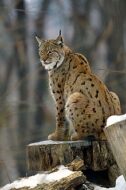
Alpine salamander
This specie of amphibians is viviparous, which means that the female does not lay eggs in the water where they would undergo the transformation to an adult animal, but gives birth to one to two fully developed babies with developed lungs capable of independent life on dry land. Their lifespan is at least 10 years long. It lives only on Alpes and Dinaric Alps.

Pančićev skakavac (Pyrgomorphella serbica)
Our famous botanist, but also a good connoisseur of grasshopper and crickets, dr Josif Pančić, has discovered a new specie of grasshopper in western Serbia, near Mokra Gora in 1881. Next year, in 1882, he described this specie in a book that was published in Vienna, written by Brunner von Watenwyl. Then, scientists were trying to find it, and in 1955 Sergie Matveiev succeded. Today, it can be found only in coniferous forests on Tara. Because of logging, they are on the list of endangered species. Together with Pančićeva omorika, it represents a symbol of Tara.
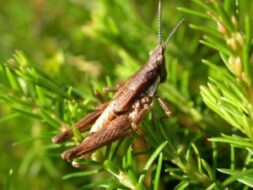
Griffon vulture
It inhabits large open areas with gorges and weak vegetation in mountainous and Mediterranean areas (steppes, semi-deserts, pastures), with drips and terraces on high and inaccessible cliffs suitable for nesting. It needs the proximity of water. Griffon vulture is our largest bird with a wingspan of about 2.8 m and an average weight of 7 to 8.5 kg, and it can reach 11 kg.
It feeds exclusively on the corpses of medium and large mammals, most often ungulates. Out of about 130 species of birds in the area of the special nature reserve „Uvac“ and its surroundings, griffon vulture is the most important species. Uvac is also home to the largest nesting colony in Serbia and one of the largest in the Balkans. The number of Beloglavi sup has been growing regularly in recent years, so that now there are about 400-500 individuals on Uvac, 110 nesting pairs.

List of organizations and their Eco Initiatives
Ecocenter
Center for Socio-Ecological Research and Documentation – Eco Center is a non-governmental, non-political non-profit organization based in Belgrade, Serbia. The Eco Center is one of the oldest civil society organizations in Serbia. The Eco Center is engaged in various activities, from scientific, through educational to public campaigns and actions.
Eco projects: INTERESTED IN THE SUSTAINABILITY OF PROTECTED AREAS (3ZA), Seminar Agro – Eco tourism as a tool for sustainable rural development
_______
Green Minutes
“Green Minutes” is an online magazine about environmental protection, sustainable development, applied ecology and healthy lifestyles. They are engaged in affirming the activities of women and youth, both in urban and rural areas, encourage programs of non-formal education, information, promotion and popularization of environmental protection and sustainable development, to develop capacities for active participation of young people and women in environmental protection and sustainable development in rural and underdeveloped areas and in protected areas and to provide support for the application of knowledge and employment of young people and women in these areas.
Eco projects: various competitions, events, dialogues and workshops, journalistic texts on the topic of ecology and sustainable development, sharing invitations from other organizations
_______
Ecohub
Through interactive projects they spread environmental awareness, encourage citizens to action and cooperate with different entities
Eco projects: ecological workshops for primary school children, workshop “Launch your ecological knowledge”, “EkoManifest” …
_______
Green List (network of local environmental organizations)
The Association of Environmental Associations “Green List of Serbia” is a network of local environmental organizations that
contribute to the preservation of natural resources and the quality of life of Serbian citizens through public advocacy, education, information and encouragement of citizens’ activism.
Eco projects: “Support program for civil society in Serbia in the field of environment (CSOnnect)”, National campaign “Planetize! Recycle II ”, National Campaign“ Planetize! Recycle, National Planet! Let’s remove landfills “…
_______
UNECO
Union of Environmentalists UNECO is a non-governmental and non-profit association. During sixteen years of work, the members of the association have gained extensive experience in the field of applied ecology and cooperation has been established with many institutions in
this field. UNECO is committed to environmental protection and acts accordingly.
Eco projects: green actions, work camps, dialogue for the prevention of natural hazards, dialogue between the EU and Serbia on the applied ecology, cleaning actions …
_______
Union of Secondary School Students of Serbia (UNSS)
Developing and strengthening the network of student parliaments in Serbia is a priority of the organization during all years of work. The
idea of UNSS is to provide high school students with the opportunity to be informed, educated and affirmed, developing in different directions through cooperation with their peers and engagement in various projects.
Eco projects: – Academy of Sustainable Development, cleaning actions (eg Tamiš quay), Eco forum, peer education (eg Recycling for beginners) …
_______
Young researchers of Serbia
A unique, non-profit, non-governmental organization, in which young people voluntarily join in order to achieve common interests, ideas and goals.
Eco projects: ECO-SYSTEM, publication “Green chair”, publication “Green decisions in your hands”, a large number of courses “
_______
Trag Foundation
Trag foundation encourages the active involvement of citizens in social change in Serbia.
Eco projects: Academy of Sustainability, volunteer camp “Eco fun camp”, Eco club …
Landfills in Serbia: Problem and Solutions
According to data from the Waste management strategies, an average resident of the Republic of Serbia produces about 318 kilograms of waste per year.
 Most of that waste ends up unsorted and at one of the many landfills in the country. There, the inadequate landfilling of waste leads to pollution of soil and groundwaters. With rain and snow soaking the landfills, harmful chemicals sink to the ground, causing health issues for wildlife and citizens living nearby.
Most of that waste ends up unsorted and at one of the many landfills in the country. There, the inadequate landfilling of waste leads to pollution of soil and groundwaters. With rain and snow soaking the landfills, harmful chemicals sink to the ground, causing health issues for wildlife and citizens living nearby.
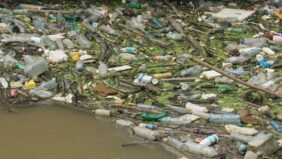 However, it’s not just the local area that’s polluted. The harmful particles that the landfills produce end up spreading and contaminating drinking water and the soil on which food is grown. Landfills in Serbia have been an ecological problem for a long time now. But, without proper care and waste sorting, the number of landfills across the country keeps growing.
However, it’s not just the local area that’s polluted. The harmful particles that the landfills produce end up spreading and contaminating drinking water and the soil on which food is grown. Landfills in Serbia have been an ecological problem for a long time now. But, without proper care and waste sorting, the number of landfills across the country keeps growing.
So, the question is, what can we do about this problem?
Our main goal should be producing less waste and living more sustainably. Therefore, by keeping the following rule in mind, we should be able to reduce the waste pile up and slow down the pollution of the Earth.
Activity :
Try following the rule of the ‘3 R’s of recycling:
It goes:
Reduce, Reuse, Recycle
Reduce:
Reduce means to minimize the amount of waste we create. The first step in reducing the amount of waste we produce is using ecologically sustainable alternatives for everyday items. Consider switching to items made from decomposable materials like a bamboo toothbrush, sustainably made clothes, etc. Reducing the use of environmentally harmful packaging is crucial as well. Using a reusable shopping bag or water bottle will significantly reduce the amount of plastic waste produced.
Reuse:
Reuse refers to using items more than once. Reusable items like storage boxes are crucial in reducing single-use plastic
Recycle:
Recycle means putting a product to a new use instead of throwing it away. Many used items can find a new purpose. For instance, we can use empty jars for storing, instead of throwing them away.
It is also important to remember not everything is reusable. In that case, we should dispose of the waste in the appropriate recycle bins.
6 steps to help prevent scary climate change scenarios
If you are interested how can you help to save our planet you can click on the link below and see 6 easy steps that can help.
Uvac Special Nature Reserve
Uvac Special Nature Reserve is a natural good of exceptional value (natural good of the first category). It’s located in southwestern Serbia within the Stari Vlah-Raška mountains. It’s surounded by mountains Zlatar, Muretnica, Čemernica, Javor, and Jadovnik; it covers an area of 7543 ha. The minimum altitude of the reserve is 760 m, and the maximum is 1322 m.
The central morphological unit of the reserve is the canyon valley of the river Uvac with the valleys of its tributaries. The waters of the river Uvac have cut their bed deep into limestone rocks and have formed narrow gorge-canyon valleys with high, steep limestone cliffs. The average depth of the valleys is between 200 and 300 m, and the maximum is up to 350 m.
The special parts of the canyon parts of the valley are the meanders. Capes of the meanders around the village of Lopiža have a relative altitude of about 100 m. The meanders of Uvac are already a recognizable picture of the southeast, but not the whole of Serbia – we are sure that they’ll be visited by many tourists from all around the world in the following years.

Picture 1: Uvac River
There are numerous karst forms: karst areas, bays, sinkholes, ditches, caves, dan pits.
The caves are numerous and vary in size from sub-caves to one of the largest known cave systems in Serbia so far, and that is the Ušački cave system; the length of the channels explored so far is 6185 m. The Ušačka cave system consists of two caves – Ušačka and Ledena, as well as the Bezdana pit that connects them. Other caves that are worth mentioning are Tubića cave, Durulja cave, Baždarska cave… All these caves by a wealth of cave jewelry deposited from the dripping waters of stalactites, stalagmites, pillars, draperies, glass needles, etc.
The Special Nature Reserve „Uvac“ singles out the presence of about 130 species of birds. The most important one is the griffon vulture (Gyps fulvus) – one of the two remaining species of vultures that nest in Serbia today.
The griffon vulture is a species of vulture eagle, imposing in size, with a wingspan of up to 3 m, which makes it a powerful flyer whose flight has been researched by aeronautical scientists and used in the construction of aircraft. Its role in the food chain in the ecosystem is unique and irreplaceable – dead animals are its only food, which prevents the spread of infections and thus represents „natural recycling“. The number of griffon vultures has increased to about 110 nesting pairs (in the Uvac canyon and the Mileševka river canyon), ie 450-500 individuals. Thus, the colony of this unique bird species became the largest in the Balkans and one of the largest in Europe.

Picture 2: The griffon vulture
It’s worth mentioning the fact that two more species of vultures that once inhabited this area have returned to the reserve area in the past few years – a black vulture (Aegypius monachus) and a white wagtail (Neophron percnopterus).
In addition to the vultures mentioned above, the area of Uvac and its surroundings was inhabited by another vulture – the bearded eagle. The Reserve will try to return this species to its centuries-old habitat, Uvac, through a reintroduction program.
Uvac Special Nature Reserve is one of the rare nesting sites of the common merganser (Mergus merganser) in Serbia. This is the largest population in the Balkans. It’s also inhabited by the white-tailed eagle, the golden eagle, the common buzzard, the short-toed snake eagle, numerous species of hawks, owls, and other birds. The presence of rare and endangered species of mammals and other fauna (such as wolves, bears, wild boars, foxes, rabbits, badgers, martens) is also significant.
The clean waters of the watercourse and reservoirs are habitats of 24 species of fish. Their parts are the natural fish hatchery of the huchen, the brown trout, the zander, the squalius cephalus, the common nase, etc.
Of the 219 registered flora taxa, three species are of international importance, three are on the Red List of Flora, 25 taxa are under the control of collection, use, and trade, and over 50 species have medicinal properties.
HOW LOCAL BUSINESSES ARE FIGHTING POLLUTION IN SERBIA








Shocking facts about climate change

Endangered plant species in Serbia
Today, 215 confirmed plant species in Serbia are put as natural values under the strictest degree of state protection. The Red lists and books list these species with detailed descriptions of them and their habitats. Every country has its Red books.
Picea omorika
A species of coniferous tree that inhabits only Western Europe and Eastern Bosnia. It is a thin and slender tree that reaches a height of up to 50 meters. This tree originates from the distant past. It was named after a serbian botanist Josif Pančić, who discovered it on Tara in 1875, near the villages Zaovina and Rastište. Picea omorika could be considered a living fossil in the world of plants because it originates from the Tertiary. The upper branches on this tree are bent upwards, the middle ones are almost horizontal, and the lower ones are bent downwards (except for the tips of the branches – they are turned upwards). It grows mainly on limestone and sometimes on serpentine.

Drosera
Drosera is a carnivorous plant that feeds itself on insects. It captures them using sticky leaves. Like a pincushion, drosera is studded with hairs, that have tiny drops on the ends. When an insect touches them, they fold and it gets trapped. Then, digestive juices are secreted and the insect will be digested in a few days’ time. It has been discovered that this plant can grow faster if it’s fed with fresh meat, cheese, and egg whites. It can be found near Vlasina Lake. The inhabitants of Vlasotince were nicknamed „Rosuljci“ after this unusual plant species.

Paeonia banatica
Paeonia banatica is a plant with beautiful red flowers. The flower is large, separated, semi-symmetrical, and reddish-pink. The fruit is sac-shaped with a larger number of seeds. It blooms in spring, from March to May. Various species of paeonia are cultivated as our favorite national flowers. This plant is poisonous and it isn’t chemically or clinically tested. Due to uncontrolled picking, it’s a rarity today. These endangered species survive only in Deliblato Sands. In Serbia, the most widespread Paeonia is Paeonia peregrina, which inhabits Eastern Europe and Kosovo.

Ramonda serbica
Another unusual discovery by Josif Pančić. Even when it’s completely dry, it can be refreshed when watered. This phenomenon was discovered by accident – when someone spilled the water on the herbarium where the plant was, the dried plant bloomed again. These beautiful and legally protected species can be found in shadows, in a habitat that lacks land and water. These extremely gentle species avoid direct sunlight and inhabit north-facing lands. Ramonda serbica can be found in the border area of the National Park of Montenegro, on the slopes of Rumija (above the village Murić).

Adonis vernalis
A perennial herbaceous plant from the buttercup family, which grows in sandy habitats and arid meadows. It was named after a hero from Greek mythology, handsome hunter Adonis. It blooms in spring, from March to May. It is represented as an ornament of Deliblato Sands and it has been protected in Vojvodina since
1978. Apart from its beauty, this plant is valued for its healing properties and is used for the production of heart medications – the reason for its rarity today. But, don’t be deceived – these species are poisonous.

Lilium bosniacum
It’s specific for its gold-colored flowers. Today, it’s highly endangered due to constant picking. Lilium bosniacum is a thousand-year-old symbol of Bosnia, an endemic flower that is a characteristic of the bosnian landscape. It was used as a symbol of purity, innocence, and beauty. It has been used by many Bosnian heroes throughout its long history. It has also found its place on the old serbian coat of arms, that was adopted in 2009. It’s identical to the former coat of arms of the Kingdom of Serbia and it represents an act of restoring monarchical symbols.


National parks of Serbia
National parks of Serbia are locations rich with natural beauty, rare flora, and fauna, but also places with exceptional cultural and historical significance. Therefore, those areas are protected by the International Association for Nature Protection. Serbia currently has 5 national parks, while Prokletije has been in the process of protection for a long time.
The Fruška Gora National Park
The eldest national park in Serbia; it acquired this status in 1960. Once an island of the Pannonian sea, the Fruška gora is now the only mountain in Vojvodina and Pannonian Bassin. It became a national park thanks to its diverse flora and fauna. At altitudes below 300 meters, you can find fertile soil and pastures, many vineyards and orchards. Above them are dense deciduous forests of sessile, hornbeam, and beech, which are one of the many greatest values of Fruška gora. Fruška gora is also known as Serbian „Mount Athos“, home of 16 Orthodox monasteries built in the 15th and 16th centuries.

The Đerdap National Park
Located in Eastern Serbia on the right shore of the Danube, near the borderline with Romania. It is the second and largest national park in Serbia. Đerdap has 4 gorges, 2 canyons, 3 vast river basis, mountain Miroč and over 1000 caves. The Danube is a habitat of rare fishes – sturgeons and belugas, while forests are the habitats of rare mammals. In the area of the Đerdap National Park, there are as many as 43 plant species that are strictly protected, while 120 of them are protected. This national park has a rich cultural heritage. At the entrance of the Đerdap gorge is the Golubac fortress, which was founded by the Romans in the 1st century BC – later, the Huns, Hungarians, and Turks fought for it. Diana Karataš is also a roman fortification in this national park. It shared the same faith as the Golubac fortress because it was destroyed by the Huns in 530. It was later reconstructed by a roman emperor Justinian. Trajan’s Board is another roman legacy and a part of a Roman road through Đerdap. Here you can also find one of the most important archeological sites in Serbia – Lepenski vir.

The Tara National Park
It acquired the status of a national park in 1981 because of its preserved forests, diversity of flora and fauna, and existence of one endemic species. Tara is well-known for Picea omorika, discovered by Josif Pančić in 1875. on this mountain. It’s an endemic species that can only be found in Western Serbia and Eastern Bosnia. A large number of different species of mosses, liches, and ferns grow on Tara. From the animal world, rare species can be found here, such as Pančić’s grasshopper (Pyrgomorphella serbica), brown bear, and chamois. You can also visit Rača Monastery, Mramorje, 5 lookouts (Crnješkovo, Bilješka stena, Osluša, Sjenic, Banjska stena) and many more. The Banjska stena outlooks Perućac lake and Drina river canyon.

The Kopaonik National Park
The most popular national park in Serbia. It was named after a mountain that acquired the status of the national park in 1981. Kopaonik was named after its mineral wealth and it has been mined on this mountain since ancient times. Rare minerals such as gold, silver, lead zinc, and iron can be found within the Kopaonik mining area. The Kopaonik National Park has rich flora and fauna. Among the protected animal species that live on Kopaonik, there are golden eagle, gray falcon, forest owl, mountain shrew, crossbill, eagle, wild cat, etc. The flora of Kopaonik is characteristic of its mixed forests of spruce, fir, maple, and beech. The natural beauties of Kopaonik include barrier lakes (Semeteško lake) and boglands (Jankova bara).

The Šar Mountain National Park
The youngest national park in Serbia (for now), founded in 1986. It’s also the highest national park in our country – even 30 mountaintops are on an altitude above 2500 meters above sea level. Šar mountain got its name from the colorful flowers that can be found there. The greatest values of this national park are the forests of molika (pinus peuce) and munika (pinus heldreichii) and more than 300 Balkan endemic species and local plant endemics (pinus mugo, rosa pendulina, Achillea alexandri-regis, Dianthus scardicus Wettst, etc). Among the natural beauties of the Šar mountains are numerous glacial lakes called Gorske oči. In addition, there’s a large number of medieval Serbian churches and monasteries on the mountain.

Top 10 worst plastic polluters in Serbia





The impact of climate change on biodiversity in Serbia
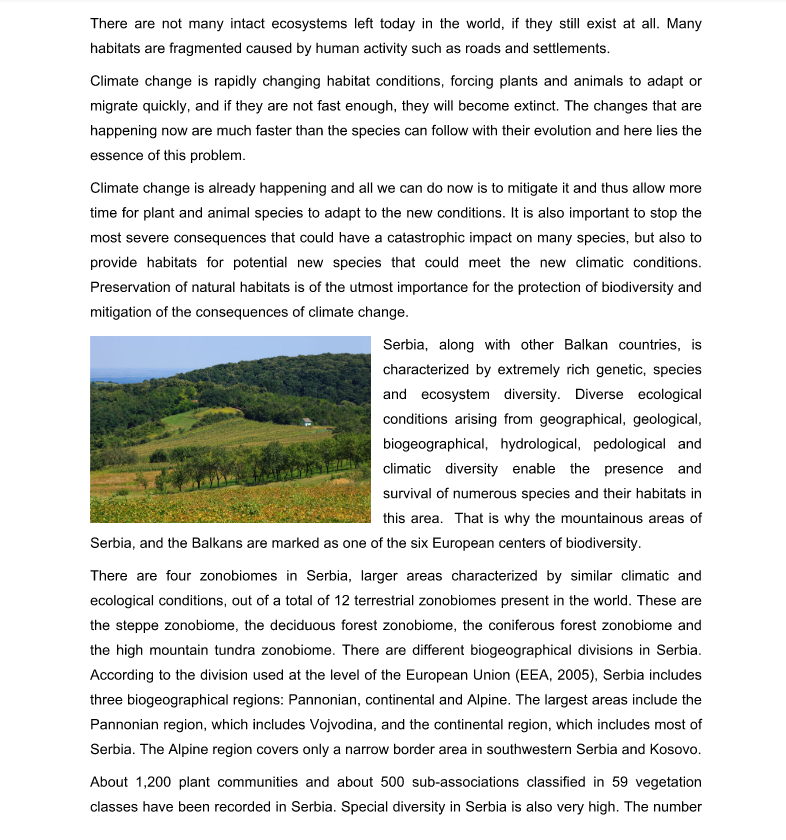
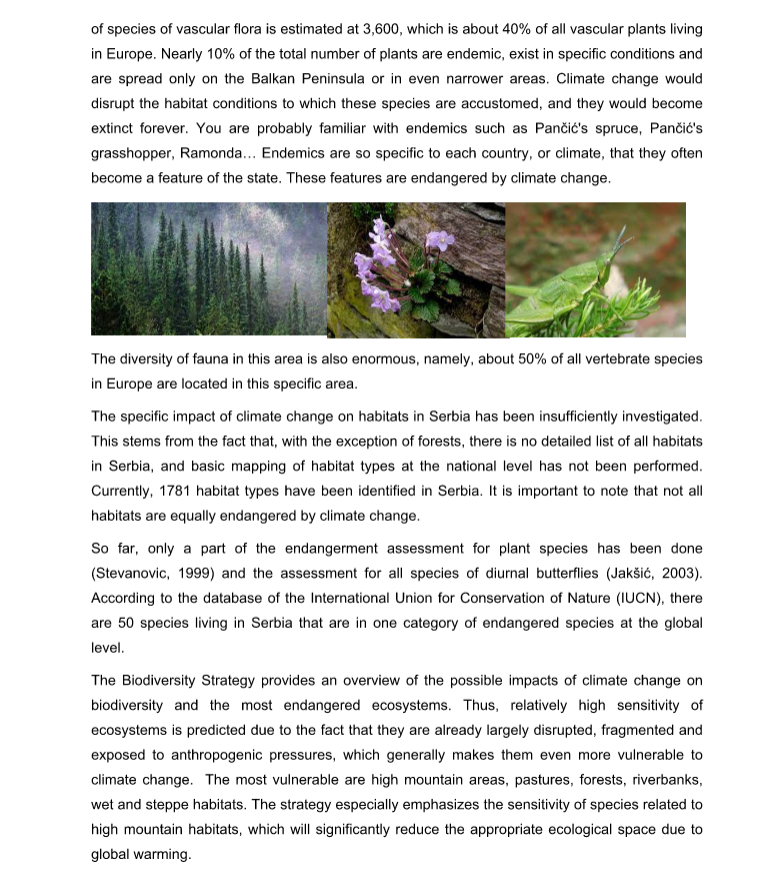
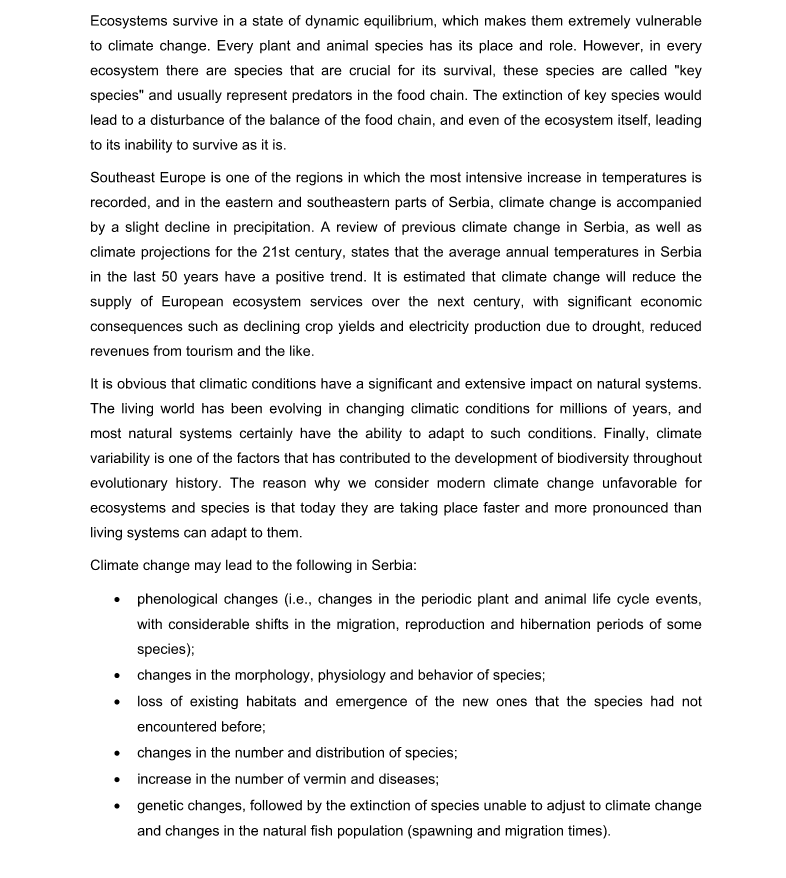
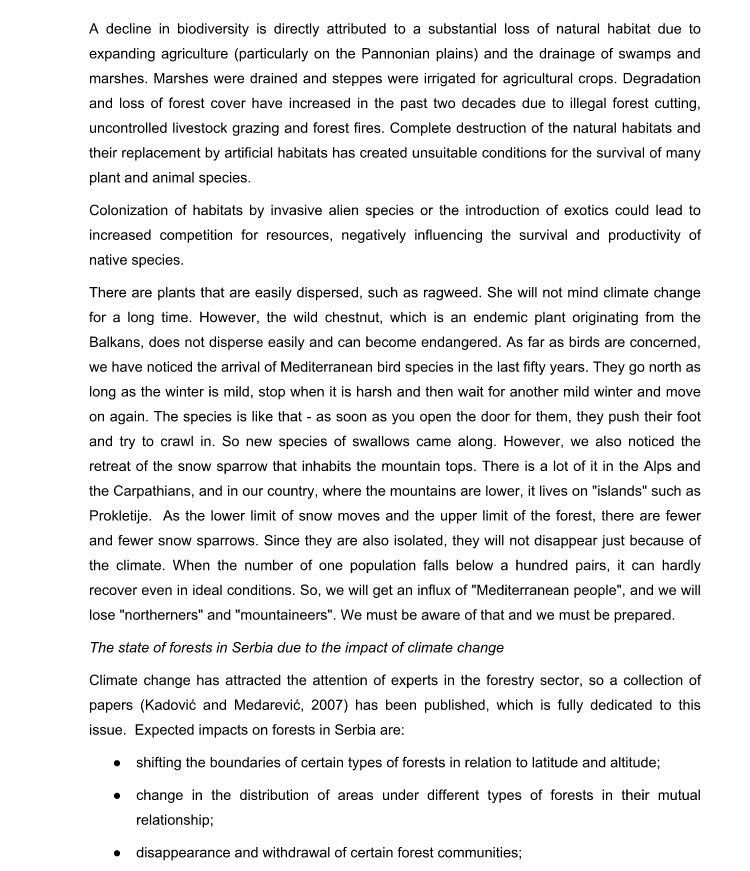
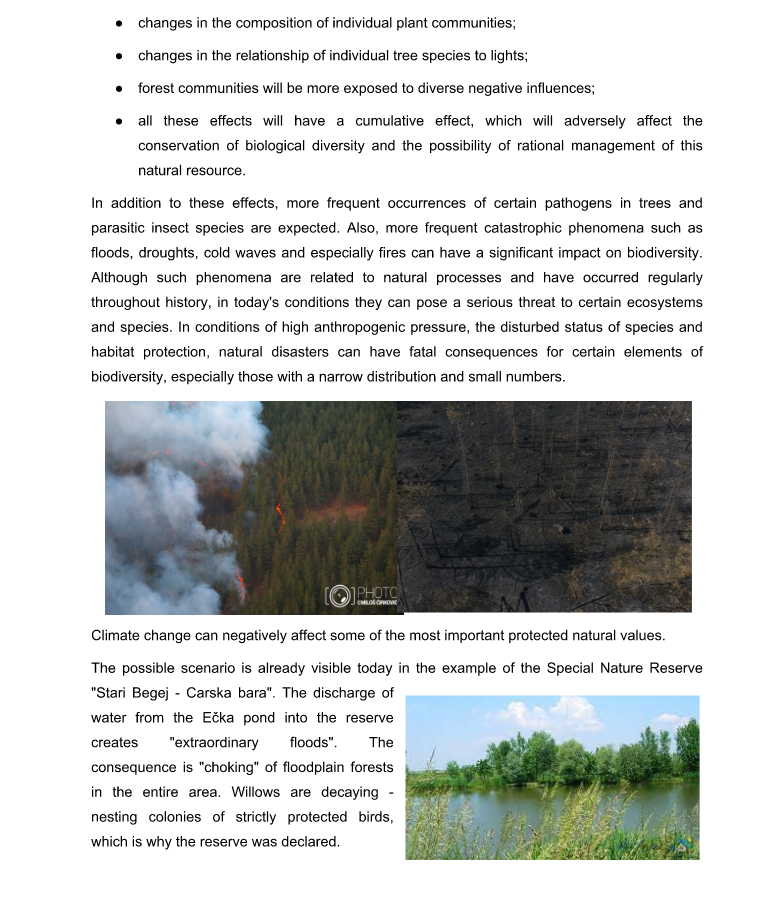

Links
-
Uvac
Visit website -
Beez&Toys
Visit website -
Starfish.radionica
Visit website -
Whitelotus_nc
Visit website -
Opanak.rs
Visit website -
Serbia.com
Visit website -
Top 10 worst plastic polluters in Serbia
Visit website

Comment
No comments